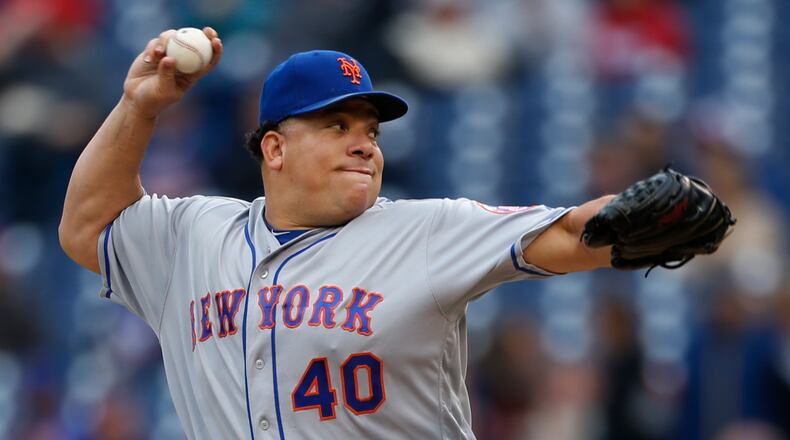Even if some of you see the wisdom in the Atlanta Braves' short-term acquisitions of Bartolo Colon, 43, and R.A. Dickey, 42, you might also be wondering: "Isn't $20 million a lot to pay for two, er, fossils?" Short answer: No.
You'll recall that the Braves entered the offseason saying they wanted to sign two starters to serve as a bridge to the wave of young pitchers who haven't yet ripened. (Had Matt Wisler and Aaron Blair, the young pitchers considered the most major-league ready, had better seasons, the bridge wouldn't have been needed. But they didn't and it was.) They wanted to buy two pitchers, as opposed to trading for them, because the Braves are determined not to shed any of their prospects unless/until it's absolutely necessary.
Buying even a mediocre starting pitcher is expensive. The Braves know that. They'd planned for this eventuality by off-loading contractual obligations for 2017. Remember the salary-dump trade -- Chris Johnson to Cleveland for Michael Bourn and Nick Swisher -- of August 2015? Remember how the Braves assumed two bad contracts for one? That was because the deals for Bourn/Swisher were due to expire after the 2016 season, whereas Johnson's ran through 2017.
The Braves wanted to clear money for next season because, to be blunt, they didn't think they'd be very good in 2016 -- they weren't, at least not for the first half of it -- and they're moving to SunTrust Park in April 2017 and they'd prefer not to stink rather less in their spiffy new surroundings. Yes, that's a hefty amount of pragmatism. Would you rather they be fanciful?
This time a week ago, the Braves had -- according to the invaluable Cot's Contracts -- only $65.5 million in salary committed to next season's roster. That put them 26th among 30 MLB teams in terms of obligation. ( Here's a graphic look from Craig Edwards of FanGraphs.)
Long story not so short: The Braves had money to spend and planned on spending it. They bought Colon for one year at $12.5 million, Dickey for one at $7.5 million. Ergo, $20 million for two old pitchers. Here's where you furrow the ol' brow and say, "Was that the wisest of outlays?" And here's where I say: Yeah.
Of this year's top 40 free agents as ranked by MLB Trade Rumors, only four were starting pitchers . The best of the four, per MLBTR, was Jeremy Hellickson, whom it projected would command $60 million over four seasons. He wound up signing a qualifying offer to stay with the Phillies for one year at $17.2 million.
Hellickson is 29. His 2016 numbers: A 3.71 ERA over 189 innings, a strikeout-to-walk ratio of 3.42, a FIP (fielding independent pitching; lower is better) of 3.98 and a Baseball-Reference WAR value of 3.0.
Colon in 2016: A 3.43 ERA over 191 2/3 innings, a K/BB ratio of 4.00, a FIP of 3.99 and a 3.4 WAR.
Dickey in 2016: A 4.46 ERA (in the American League) over 169 2/3 innings, a K/BB ratio of 2.00, a FIP of 5.03 and a WAR of 0.4.
Colon was a bit better than Hellickson last season; Dickey was significantly worse. Note that the Braves couldn't have signed Hellickson for $17.2 million. Only his current club could have done that. (And the Braves would have lost a draft pick if they had; because Colon and Dickey hadn't gotten qualifying offers, the Braves lost no picks.)
Any team other than the Phillies would surely have had to pay bigger for Hellickson and offer more years. Think of it this way: The Braves got two starting pitchers for $2.8 million more than the Phillies paid to keep one. The Braves lost no prospects and kept all their draft picks. They're obliged to pay Colon and Dickey only $500,000 beyond this season. (Dickey has a buyout if the club doesn't exercise its option.)
On the free-agent market, nothing costs more than starting pitching. (We say again: David Price for $217 million, Zack Greinke for $206.5 million.) The Braves are organizationally disposed not to shop for free agents unless there's an absolute need, which there was. They wanted two starting pitchers. They got two innings-eaters for $20 million over one season.
MLB Trade Rumors projects that Ivan Nova -- who turns 30 in January and has a career ERA of 4.30 -- will sign for $52 million over four seasons . That's $13 million per year, which is less than the Braves are paying Colon (ERA of 3.93 over a much longer career) for 2017. And the Braves didn't want a free-agent pitcher for four years. They wanted two starters for next year. They had both in hand two weeks before Thanksgiving. They do not mess around.
About the Author
The Latest
Featured



